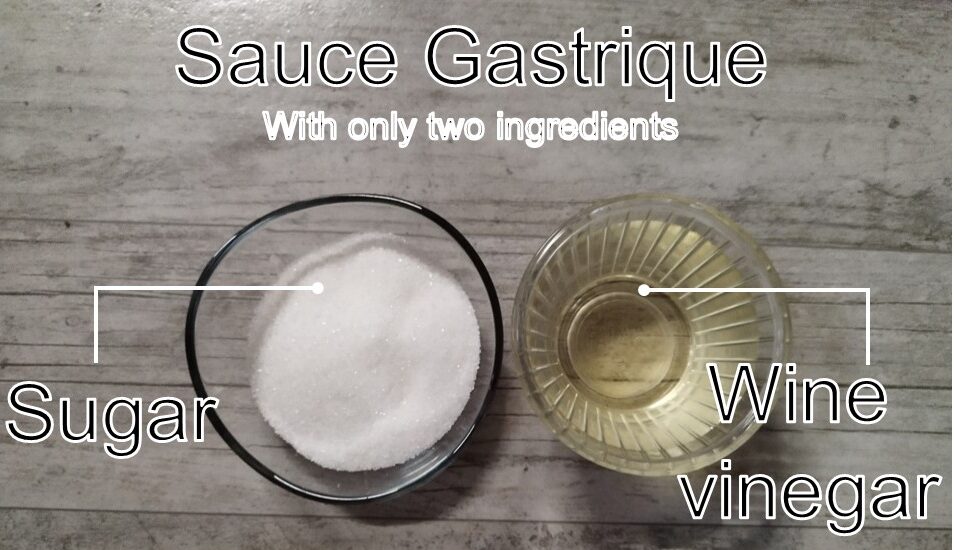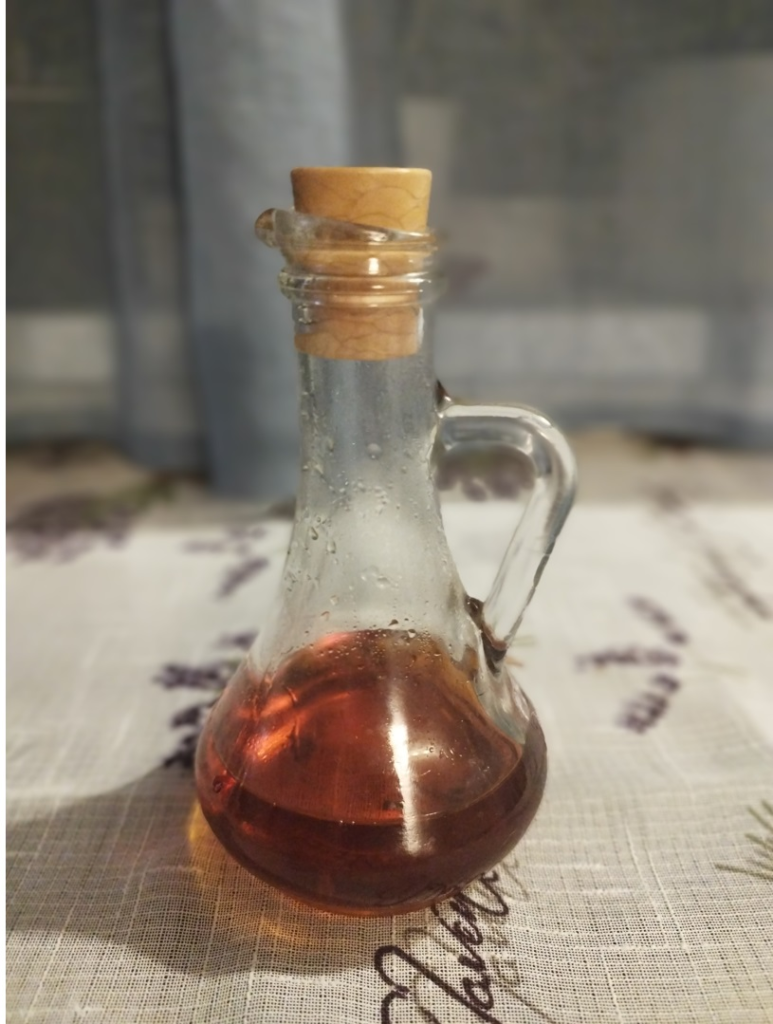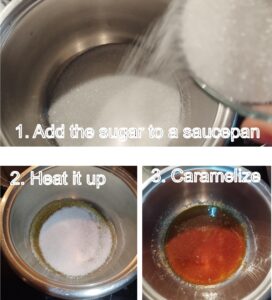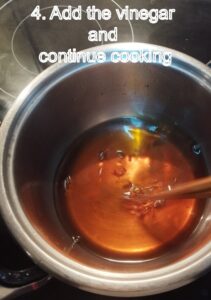Gastrique: The Sweet-and-Sour Balance

Sauce gastrique is a French vinegar-based sauce, a cousin to the Italian* and Asian** sweet and sour sauces. You, like me have maybe heard Gastrique because of the classic dish duck à l’orange (Duck breast with orange sauce). It the backbone of some sweet-and-sour or fruit sauces, the ones that go especially well with fatty foods such as duck. I will make some of them and will share the recipe with you, but for now I wanted to show you the most simple form that this kind of sauces have to offer.

It’s a well-known fact and a culinary tradition in many countries that when you pair sweet-and-sour + fat the dish becomes less cloying and balanced. Classical examples are duck + orange, pork + apple or berries, beef + wine reduction. All of them rely on the balance between sourness, sweet and fatty. Each ingredient balanced the rest of the dish in a unique way- sour taste balances the fatty taste, the sugar taste of the sauce softens and balances the sour edge, making it pleasant and not a all harsh. The result- light and fresh feel, but not heavy and overwhelming.
* Agrodolce
** Táng cù
Culinary Usage of sauce gastrique:
- Sauce Gastrique can be a versatile tool in your arsenal. It can be the basis sweet and sour sauces.
- Gastrique sauce can be also used for deglazing the fond (sucs) from the bottom of a pan after roasting or pan-frieng meat and vegetables, creating a complex sauce.
- Experiment with the components- instead of wine white vinegar you can use rice vinegar (Asian style) or instead of white table sugar one can use honey (table 1 and 2).
- Mixologists are using it as a fresher flavor component of some coctails instead of simple syrup
- Gastrique with fruit – the classical French recipe calls for use of only white table sugar and vinegar, but depending on the accompanied dish you can add different fruits like apple, orange, berries etc that can compliment different types of meat (duck-orange, pork-apples etc.)
Alternative Vinegars and Sugars for Gastrique
Vinegar Options for you to try
| Vinegar Type | Flavour Profile | Best Used With |
| Balsamic Vinegar | Rich and sweet | Roasted vegetables, duck, cheese |
| Apple Cider Vinegar | Fruity, sharp | Pork, chicken, apple-based sauces |
| Rice Vinegar | Mild, slightly sweet | Seafood, Asian dishes, tofu |
| Champagne Vinegar | Light, elegant | Shellfish, white meats |
| Red Wine Vinegar | Robust, acidic | Game meats, beef, pork, berries |
| White Wine Vinegar | Clean, sharp | Fruit sauces, poultry |
| Sherry Vinegar | Nutty, complex | Mushrooms, root vegetables |
Sugars that work well with Gastrique
| Sugar Type | Flavor Profile | Best Used With |
| White Sugar | Neutral sweetness, caramel | Classic gastrique base |
| Brown Sugar | Caramel, molasses notes | Pork, squash, onions |
| Honey | Floral, smooth sweetness | Duck, cheese, fruit sauces |
| Maple Syrup | Earthy, woody sweetness | Game meats, nuts, autumn vegetables |
| Mirin | Sweet rice wine | Seafood, Asian fusion dishes |
| Agave Syrup | Light, clean sweetness | Tropical fruits |
| Palm Sugar / Date Syrup | Deep, rich sweetness | Exotic sauces, fusion cuisine |
Dishes Where Sauce Gastrique Is Essential:
- Classical Duck à l’orange using gastrique as a base for Sauce Bigarade (Duck Breast with Orange sauce)
A French classic dish combining the fatty richness of the duck with the delicate sweet-acidic sauce, in perfect balance* with each other - Pork with Apple or Peach Gastrique
- Game meat with Cherry Gastrique
- Salmon with Raspberry or Citrus Gastrique
- Poultry with Citrus Gastrique
- Grilled Halloumi with Pomegranate Gastrique
- Roasted Pumpkin with Balsamic Gastrique
- (*see why below).
Preparation
Its one of the easiest recipes you will ever do. Combine approximately one part sugar to one or two parts wine vinegar by volume. How much Gastrique you add as a base really depends on personal preferences, but the general rule of thumb is to add around 2 tbsp or 30ml per liter of sauce. In the traditional French making white wine vinegar (fruity with a sweet nuance) is used, but apple cider vinegar, red wine or cherry vinegar can also be used (table 1) (1).
To prepare appr. 100ml of sauce gastrique, heat 100g white sugar (or other type) in a saucepan to a medium heat. In about 5 min the sugar will start to melt, and it will turn deep brown red. If you are not paying attention, it will go out of hand quickly. My suggestion is to stay next to the stove and observe the caramelization process. I have done it, not once- it goes from brown to black in a blink.
When you have caramelized sugar pour 125ml of vinegar of your choice into the saucepan and continue cooking and stirring until all the caramel has been dissolved (when you add the vinegar, the caramel will crystallize- a crust will form on top of the sauce, which after 4-5 min it will dissolve in the solution). When pouring the vinegar beware of spatters. Some recipes call for combining the sugar and the vinegar in the beginning, but the high heat needed for the preparation of the caramel will cook almost all the vinegar (1).
Fruit Version
If you want to try the fruit versions of the sauce, I will recommend adding the fruits diced in cubes a few minutes before you caramelize the sugar. The heat from the pan will make them sweat, drawing out the fructose, which will blend nicely into the sauce.
Storing and shelf life of Gastrique Sauce.
You can keep the sauce in the refrigerator for about 1-2 mounts.
The science of balancing sweet and sour with fatty foods
Now that we’ve made the sauce, let’s look at why it works so beautifully from a sensory and chemical perspective.
Duck contains much more fat than poultry like chicken or turkey, and that can make you feel it heavier on the palate. Even so, when coupled with sweet-and-sour sauce like gastrique, the perception of fat changes — although the proportion of fat itself doesn’t. The acid content of the sauce (the vinegar) is important. Sourness stimulates the production of saliva, and the extra saliva helps wash away fatty droplets from receptors (2). On the other hand, the saliva contains an enzyme (lingual lipase) which additionally breaks down esterified fatty acids, found in the meat, to a short chain fatty acids that can bind to fat taste receptors (3).
The most interesting part in the whole story is that the main component of the vinegar is acetic acid, which itself is a short-length fatty acid (C2, CH3COOH). Unfortunately, I did not find any evidence in the literature of it binding to the receptor and eliciting a response.
So, the simplest explanation will be key here. Fat taste (Olegustus; Latin for “a taste for fat.) has modalities (5). The short-chain fatty acid can elicit a sensation similar to that of a sour taste. Medium- and long-chain fatty acids can elicit a subtle bitterness (4,5). Even when fat taste is detected, it remains very mild and distant compared to other primary tastes (sweet, sour, bitter, umami and salty). Combined with a sweet-and-sour sauce, the perception of fat becomes lighter, fresher, and more balanced — just try it.
References:
- Peterson, J. (1998). Sauces: Classical and Contemporary Sauce Making (2nd ed.). John Wiley & Sons. (Original sauce recipe)
- Christensen, C. M., Brand, J. G., & Malamud, D. (1987). Salivary changes in solution pH: a source of individual differences in sour taste perception. Physiology & Behavior, 40(2), 221–227. https://doi.org/10.1016/0031-9384(87)90211-3
- Neyraud, E., Cabaret, S., Brignot, H., Chabanet, C., Labouré, H., Guichard, E., & Berdeaux, O. (2017). The basal free fatty acid concentration in human saliva is related to salivary lipolytic activity. Scientific Reports, 7(1), 5969. https://doi.org/10.1038/s41598-017-06418-2
- Gilbertson, T. A., Boughter, J. D., & Hirata, H. (1997). Evidence that the rat fatty acid taste receptor is activated by nonesterified fatty acids. Chem Senses, 22(4), 391-395.
- Running, C. A., Craig, B. A., & Mattes, R. D. (2015). Oleogustus: The Unique Taste of Fat. Chemical Senses, 40(7), 507–516. https://doi.org/10.1093/chemse/bjv036
Sauce Gastrique
Ingredients
Method
- Gather and measure the ingredients.

- Heat 100 g sugar in a saucepan over medium heat (~5 min) until it melts and turns deep red-brown.

- (Optional) Add the diced fruit slight before the sugar start to caramelize. In that way the natural sugars in the fruit lightly caramelize too, enhancing depth and aroma.
- Add 125 ml vinegar. Caramel will crystallize- a crust will form on top of the sauce, which after 4-5 min it will dissolve int he solution.

